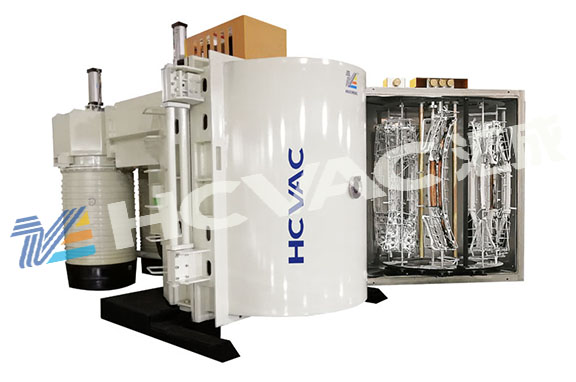Evaporation pvd coating machine coats low melting point materials such as aluminum, magnesium fluoride, zinc sulfide, etc. It is widely used in packaging, plastics, furniture industries, etc., with low cost, high efficiency and high market share. The following is a vacuum editor for everyone. Introduce the coating principle of the evaporation pvd coating machine in detail:

1. Principle of vacuum evaporation
(1) Vacuum evaporation is to heat and evaporate the plating material under vacuum conditions, so that a large number of atoms and molecules vaporize and leave the liquid plating material or leave the surface of the solid plating material (sublimation).
(2) Gaseous atoms and molecules migrate to the matrix after few collisions in vacuum.
(3) The atoms and molecules of the plating material are deposited on the surface of the substrate to form a thin film.
(2) Evaporation source
The plating material is heated to the evaporation temperature and vaporized, and this heating device is called the evaporation source. The most commonly used evaporation sources are resistance evaporation sources and electron beam evaporation sources. Evaporation sources for special purposes include high-frequency induction heating, arc heating, radiation heating, and laser heating evaporation sources.
Example of vacuum evaporation process Taking plastic metallization as an example, the vacuum evaporation process includes: pre-plating, coating and post-processing.
The basic process of the evaporation pvd coating machine coating process is as follows:
(3) Examples of vacuum evaporation process Taking plastic metallization as an example, the vacuum evaporation process includes: pre-plating, coating and post-processing.
(1) Pre-plating treatment, including cleaning the plated parts and pre-treatment. Specific cleaning methods include cleaning agent cleaning, chemical solvent cleaning, ultrasonic cleaning and ion bombardment cleaning. The specific pretreatment includes removing static electricity, applying primer and so on.
(2) Furnace installation, including cleaning of vacuum chamber and cleaning of plating hangers, installation and debugging of evaporation source, and plating of jackets.
(3) Vacuuming, generally first rough pumping to above 6.6Pa, opening the front stage of the diffusion pump to maintain the vacuum pump earlier, heating the diffusion pump, and after the preheating is sufficient, open the high valve, and use the diffusion pump to pump to 6 × 10- 3Pa half bottom vacuum.
(4) Baking, heating the plated parts to the required temperature.
(5) Ion bombardment, the vacuum degree is generally 10Pa ~ 10-1Pa, the ion bombardment voltage is 200V ~ 1kV negative high voltage, and the ion bombardment time is 5min ~ 30min,
(6) Pre-melting, adjusting the current to pre-melt the plating material, adjusting the current to pre-melting the plating material, and degassing for 1min-2min.
(7) Evaporation deposition, adjust the evaporation current as required until the required deposition time ends.
(8) Cooling, the plated parts are cooled to a certain temperature in a vacuum chamber.
(9) released,. After taking the parts, close the vacuum chamber, evacuate to 1 × 10-1Pa, and the diffusion pump can be cooled to the allowable temperature before closing the maintenance pump and cooling water.
(10) After treatment, apply topcoat.
The evaporation
pvd coating machine can only evaporate the film material with low melting point, and the film material with high melting point can only use other coating technologies, such as ion coating technology, magnetron coating technology, electron beam coating technology, etc.



